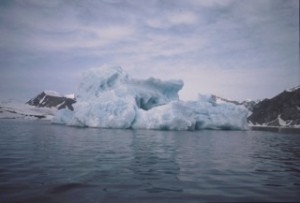Outside there’s a brief hole in the rain, but by this evening South Wales will be lashed again with the kind of downpour you only used to see in tropical monsoons, although here of course the deluge comes at an angle and at a lower temperature! On the other side of the Atlantic, Eastern Canada and the midwest suffer temperatures twice as cold as the shelves inside my freezer.
The radio this morning broadcast an interview with a guy from ‘Hell’ Ilinois where the unprecedented low temperatures have allowed newspaper editors the indulgence of the headline ‘Hell Freezes Over’. The Hell resident said the low temperatures made him doubt ‘global warming’, and I’m sure climate change skeptics will be using the cold weather as ammunition. But whatever the doubters think, both storms and cold and all the other incidences of weird weather I’ve come across this past year or so, from unseasonal rain patterns in Malawi to late freezes in Italy – are manifestations of climate change. ‘Global warming’ doesn’t mean avocado trees in the back garden in Surrey, it means a loss of seasonal predictability, a messing up of the pattern to which plants and animals are adapted, and that includes the plants and animals that are our crops and our food.
No matter how divorced we may feel from the natural world, the fact is we are still utterly, utterly dependent upon it for our survival, so this muddling up of weather matters: when do you plant a crop if you don’t know when it’s going to rain? how do you keep animals healthy if the cold snap that usually kills off pathogens, doesn’t come? So there are aspects of this current extreme weather that I like. First of all it should be a wake up call for governments still whining about the jury being out on global climate change. Second, it reminds us that our techno world doesn’t protect us from everything nature can do, and that however much our activities are messing things up, we are still not the biggest show on earth. This I think is a very, very good thing for our mental health. The big absolutes of nature show us our place and help to keep our priorities in order.
I always think a lot about human relationships with nature – of course, that’s my life’s obsession – but I’ve
been thinking recently about the most extreme, hardcore version of those relationships, that of subsistence hunters in the Arctic. I’m researching a new title in my Heros of The Wild series, stories for 8-12 year olds that tell a real conservation story through the medium of fiction. I wanted to do something about the bowhead whale refuge set up by the WWFN on the coast of Baffin Island in the Canadian Arctic. But as bowheads have a long history of exploitation by both aboriginal and commercial whalers, people and hunting are right at the heart of the species’ story. So I’ve been reading a lot about Inuit culture – the ingenuity and community that enabled human beings to survive in minus 40C with nothing but bone, stone and sinew to help them. Just as with all things shaped by natural selection, I’ve been astonished at the beauty of the objects made by Inuit invention – flint harpoon heads, waterproof parkers made from seal gut, skin boats, snow houses, polar bear trousers. But it isn’t just the objects that were made lovely by the ruthless pruning of absolute necessity, it is the people themselves. Time and time again in interviews I’ve read and watched on film of Inuit, Saami and other native people who still live by hunting or herding in that most demanding of all environments, the Arctic, I’ve been struck by their gentleness and quiet – not passive at all, a kind of dynamic still ness. I think that just as the cold flow of polar water moulds the fat streamlines of a seal, the stark necessities of working to natures agenda mould human behaviour. All that is not adaptive is simply stripped away. Impatience, anger and stress over small things, inability to defer gratification – all these make a poor hunter. A hunter who doesn’t share doesn’t get shared with. Both poor hunters, and selfish hunters end up starved to death.
Inuit were traditionally held in tight communion with nature. The tension in the binding between humans and the natural world was kept by a life and death necessity, daily apparent in their every action in reaction to the natural world around them.
In the last fifty years that tension has gone. For the vast majority of Inuit the encroachment of a cash economy has slackened the rope tying them to nature. They are no longer pruned into shape by a constant ruthless negotiation with the wild. Many communities are consumed with problems – alcohol, drugs, violence and horrific suicide rates among the young men.
But in reality that tight binding between humans and nature is still there. It’s just moved so its harder for Inuit and for us to see it. The rope is longer, it twists around and through many more things. It runs back and forward through time – back millions of years to the forests that created the deposits of petroleum, and forward to the future climate that we are creating through releasing millions of years worth of photosynthetically fixed carbon from those forests, in a few centuries.
The new behaviour that we must learn is to find new ways to feel that old connection, that links us to nature as surely as the chord tied us to our mother’s womb. We need to feel its tautness and let it shape our lives and our being. We need to re learn the old ways, the old respect that the elders of the Inuit and the Saami held deep in their hearts.



